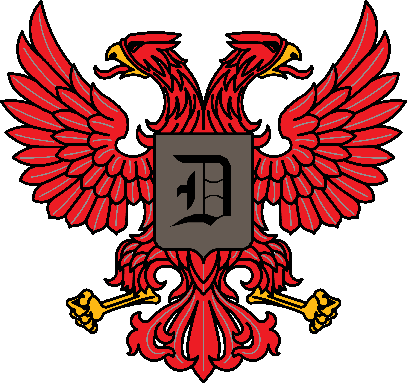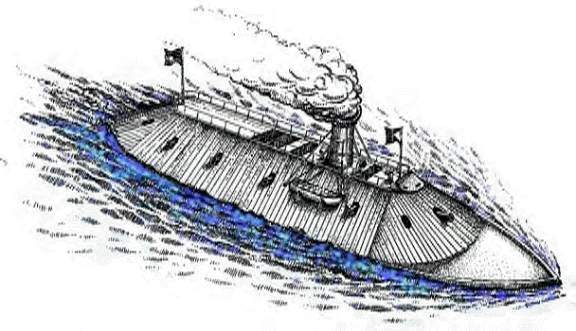

EACHDRAIDH DUNLOP
FOOTSTEPS OF OUR CLAN
How
the Dunlops had roles in one of the most famous battles in Naval History:
The
USS Monitor vs. the CSS Virginia (Merrimack)

![]()
The CSS Virginia
By
Mike Dunlap, Clan Historian
Engagement of the Steam Sloop Iron plated CSS Virginia of ten guns; the
Patrick Henry, of 6 guns, the Jamestown, of two guns; the
Raleigh, the Beaufort, and the Teaser, all of one gun
each…against the frigates USS Cumberland, of 24 guns; the Congress,
of 50 guns; the St Lawrence, of 50 guns; and the steam frigates USS
Minnesota and USS Roanoke , each of 40 guns.
From
the Official Records, Union and Confederate Navies, Series 1, Volume 7.
Washington DC 1898.
Report of Captain Von Brunt, US Navy, Commanding the USS Minnesota, March
8-10, 1862. to the Honorable Gideon Welles, Secretary of the Navy, USA:
Sir:
On Saturday, the 8th instant, at 12:45 p.m., three small steamers
were discovered rounding Sewell’s Point (near Hampton Roads, Virginia), and as
soon as they came into full broadside view I was convinced that one was the
iron-plated steam battery Merrimack, from the large size of her smoke
pipe. They were heading for Newport News, and I, in obedience to a signal from
the senior officer present, Captain J. Marston, immediately called all hands,
slipped my cables, and got underway for that point to engage her. While rapidly
passing Sewell’s Point the rebels there opened fire on us from a rifle battery,
one shot from which going through and crippling my mainmast. I returned the fire
with my broadside guns and forecastle pivot. We ran without further difficulty
within about one and a half miles of Newport News, and there, unfortunately,
grounded. The tide was running ebb, and although in the channel, there was not
sufficient water for this ship, which draws 23 feet. I knew that the bottom was
soft and lumpy, and endeavored to force the ship over, but found it was
impossible to do so.
At
this time it was reported to me that the Merrimack had passed the frigate
Congress and run into (rammed) the sloop of war Cumberland, and in
fifteen minutes after I saw the latter going down by the head (sinking). The
Merrimack then hauled off, taking a position, and about 2:30 pm engaged the
Congress, throwing shot and shell into her with terrific effect, while
the shot from the Congress glanced from her iron-plated sloping sides
without any apparent damage. At 3:30 pm the Congress was compelled to
haul down her colors. Of the extent of her loss and injury you will be informed
from the official report.
At 4
pm the Merrimack, Jamestown, and Patrick Henry bore down upon my
vessel. Very fortunately the iron battery drew too much water to come within a
mile of us. She took a position on my starboard bow, but did not fire with
accuracy, and only one shot passed through the ship’s bow. The other two
steamers took their position on my port bow and stern, and their fire did the
most damage in killing and wounding men, inasmuch as they fired with rifled
guns; but with the heavy gun that I could bring to bear on them I drove them
off, one of them apparently in a crippled condition. I fired on the Merrimack
with my pivot 10-inch gun without apparent effect, and at 7pm she too hauled off
and all three vessels steamed toward Norfolk.
The
tremendous firing of my broadside guns had crowded me father upon the mudbank,
into which the ship seemed to have made for herself a cradle. From 10 p.m. ,
when the tide commenced to run flood until 4 am, I had all hands at work with
steam tugs and hawsers, endeavoring to haul the ship off of the bank, but
without avail, and, as the tide had then fallen considerably, I suspended
operations at that time. At 2 am the iron battery USS Monitor, Commander
John Worden, which had arrived the previous evening from Hampton Roads, cane
alongside and reported for duty, and then all on board felt that we had a friend
that would stand by us in our hour of trial.
At 6
am the rebels again appeared, and I beat the men to quarters. The Merrimack
ran down and turned into the channel through which I had come last night. When
she approached within a mile I opened upon her with my stern guns and made
signal to the Monitor to engage the enemy. She immediately ran down my
wake, right into range of the Merrimack, completely covering my ship as
far as possible with her smallish dimensions, and much to my astonishment, laid
herself right alongside the Merrimack, and the contrast was that of a
pigmy to a giant. Gun after gun was fired by the Monitor, which was
returned with whole broadsides from the Merrimack with no more effect,
apparently, than so many pebble stones thrown by a child. After a while they
commenced maneuvering , would shoot by the rebels and rake her from the stern.
In the meantime the rebels were pouring broadside after broadside, but almost
all her shot flew over the little submerged propeller. When they struck the
bomb-proof tower the shot glanced off without producing any effect, clearly
establishing the fact that wooden vessels can not contend successfully with
ironclad ones; for never before was anything like it dreamed of by the greatest
enthusiast in maritime warfare! After the Merrimack determined that she
could not damage the Monitor, she returned her attention to the
Minnesota. We opened upon her with a broadside and a 10-inch pivot gun that
would have blown out of the water any timber ship in the world. She returned my
fire with her rifled bow gun with a shell that passed through the chief
engineer’s stateroom, amidships, and burst in the boatswains room, tearing all
four rooms into one with its passage, exploding two charges of powder, which set
the ship on fire. Her second shot went through the boiler of the tug USS
Dragon, destroying it totally. This time I concentrated upon her an
incessant fire from my gun deck, spar deck, and forecastle pivot guns, and was
informed by my marine officer, who was stationed on the poop deck, that at least
fifty solid shot struck the Merrimack on her slanting ironclad side
without any apparent effect.
By
the time she had fired her third shell the Monitor had come down upon
her, and placed herself between us and the Merrimack, forcing the
Merrimack to maneuver and run aground. We then poured into her all the guns
that could be brought to bear . She did get off and withdrew down the bay, with
the Monitor in hot pursuit, when she turned around and ran full speed
into the Monitor. For some time they fired into the tower and pilot house of the
Monitor, until she turned and headed for Fort Munroe. The Merrimack
and two of her steamers again turned toward us , but decided that we were
finished, and headed for Craney island instead . (Serving aboard the USS
Minnesota was Charles Dunlap, seaman, mortally wounded when the first shell
from the Merrimack passed through the Engineer’s stateroom and ignited
the powder stores.)
Report excerpt of S.R. Mallory, Secretary of the Navy of the Confederate States,
to Jefferson Davis, President, CSA:
Sir,
I have the honor to lay before you the official report of the naval engagement
between the James River squadron, under the command of Flag-Officer Franklin
Buchanan, Captain of the CSS Virginia (Merrimack), and the Enemy’s
fleet at Hampton Roads on the 8th instant. The engagement commenced
at 3:30 pm and at 6 pm he had sunk the Cumberland, captured and burned
the Congress, disabled and driven the Minnesota ashore, and
defeated the St Lawrence and Roanoke, who sought shelter under the
guns of Fortress Monroe. Two of the enemy’s small steamers were blown up and two
transports were captured. Damage to the CSS Virginia was minimal. The
conduct of the officers and men of the squadron in this contest reflects
unfading honor upon themselves and upon the Navy. It will be remembered that the
Virginia was a novelty in naval architecture, wholly unlike any ship that
ever floated; that her heaviest guns were equally a novelty; that her motive
power and her obedience to her helm were untried; and her officers and crew
strangers to her and each other; and yet, under all these disadvantages, the
dashing courage and consummate professional ability of Flag-Officer Buchanan and
his associates achieved the most remarkable victory which naval annals record!
(Serving aboard the CSS Virginia, from Nov. 1861 till May 1862 was John
Dunlap, seaman, who survived this battle and the war.)
The
footsteps of our Clan tread across the deck of the first ironclad vessel in
Naval History. "Merito!"
